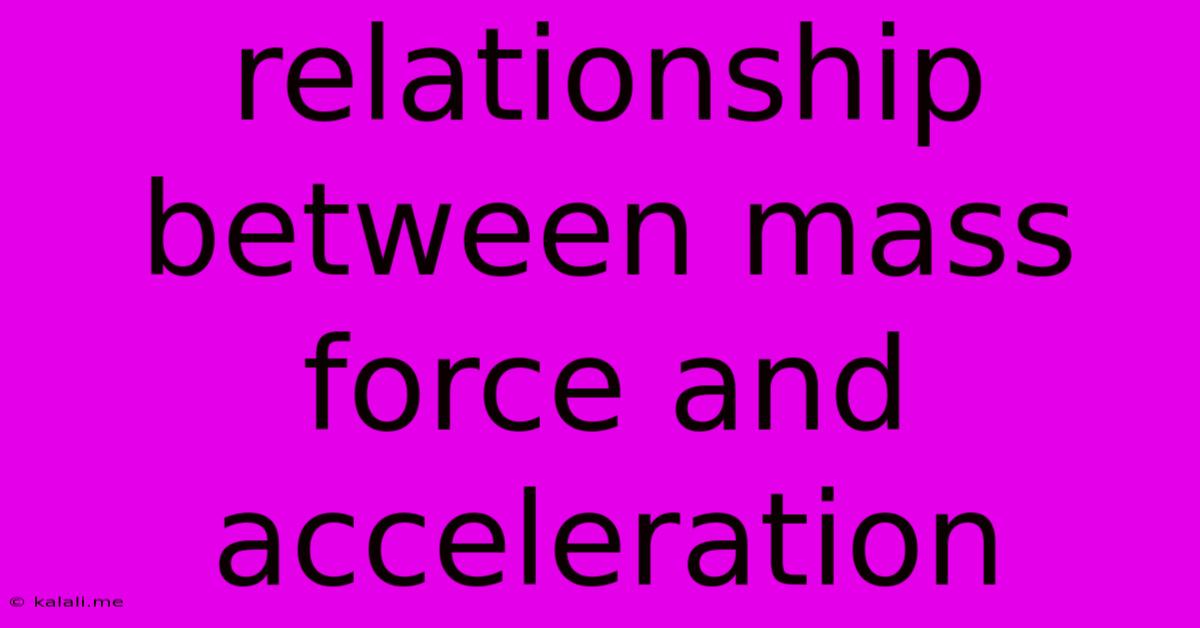Relationship Between Mass Force And Acceleration
Kalali
Jun 16, 2025 · 3 min read

Table of Contents
The Inseparable Duo: Understanding the Relationship Between Mass, Force, and Acceleration
Newton's second law of motion is a cornerstone of classical mechanics, elegantly describing the relationship between force, mass, and acceleration. This simple yet profound law governs how objects move in response to applied forces, shaping our understanding of everything from the trajectory of a thrown ball to the motion of planets. This article delves into the intricate relationship between mass, force, and acceleration, exploring its implications and applications.
Newton's Second Law: The Foundation
At its core, Newton's second law states that the acceleration of an object is directly proportional to the net force acting on it and inversely proportional to its mass. This can be expressed mathematically as:
F = ma
Where:
- F represents the net force (measured in Newtons, N) acting on the object. This is the vector sum of all forces acting on the object.
- m represents the mass (measured in kilograms, kg) of the object – a measure of its inertia, or resistance to changes in motion.
- a represents the acceleration (measured in meters per second squared, m/s²) of the object – the rate at which its velocity changes.
Understanding the Components
Let's break down each component to better grasp their interplay:
Mass: The Resistance to Change
Mass is a fundamental property of matter. A larger mass indicates a greater resistance to changes in motion. Think of pushing a shopping cart versus a car – the car, possessing significantly more mass, requires a much greater force to achieve the same acceleration. This resistance to acceleration is known as inertia.
Force: The Cause of Acceleration
Force is an interaction that can alter an object's motion. Forces can be contact forces (like pushing or pulling) or non-contact forces (like gravity or magnetism). The net force is crucial; if multiple forces act on an object, their vector sum determines the resulting acceleration. A net force of zero means no acceleration – the object remains at rest or continues moving at a constant velocity (Newton's first law).
Acceleration: The Result of the Interaction
Acceleration is the change in velocity over time. A positive acceleration means the object is speeding up; a negative acceleration (deceleration) means it's slowing down; and zero acceleration means constant velocity. The acceleration is directly proportional to the net force – a larger force leads to a larger acceleration, provided the mass remains constant.
Practical Applications and Examples
The relationship between mass, force, and acceleration is fundamental to countless applications:
- Designing vehicles: Engineers use this principle to calculate the engine power needed to accelerate a vehicle of a given mass to a desired speed.
- Space travel: Calculating the thrust required to launch a rocket into space necessitates a precise understanding of the rocket's mass and the desired acceleration.
- Sports: The force applied to a ball during a throw directly impacts its acceleration and, consequently, its trajectory and speed.
- Understanding collisions: Analyzing collisions involves applying Newton's second law to determine the forces involved and the resulting changes in velocity.
Beyond the Basics: Considering Other Factors
While F=ma is a foundational equation, it's crucial to remember that it applies primarily to situations involving constant mass and neglecting relativistic effects. In more complex scenarios, such as those involving variable mass (like a rocket expelling fuel) or extremely high speeds, more sophisticated models are required.
Conclusion
The relationship between mass, force, and acceleration, as encapsulated by Newton's second law, is a cornerstone of our understanding of motion. This fundamental principle permeates numerous fields, enabling the design of everything from everyday objects to sophisticated technologies. By understanding this relationship, we can gain a deeper appreciation of the physical world around us.
Latest Posts
Latest Posts
-
How To Create Clickable Image In Html
Jun 16, 2025
-
What Are The Factors Of 121
Jun 16, 2025
-
What Is A Theme Of The Passage
Jun 16, 2025
-
A Company That Provides Access To The Internet
Jun 16, 2025
-
Which Word Is Closest In Meaning To The Underlined Word
Jun 16, 2025
Related Post
Thank you for visiting our website which covers about Relationship Between Mass Force And Acceleration . We hope the information provided has been useful to you. Feel free to contact us if you have any questions or need further assistance. See you next time and don't miss to bookmark.